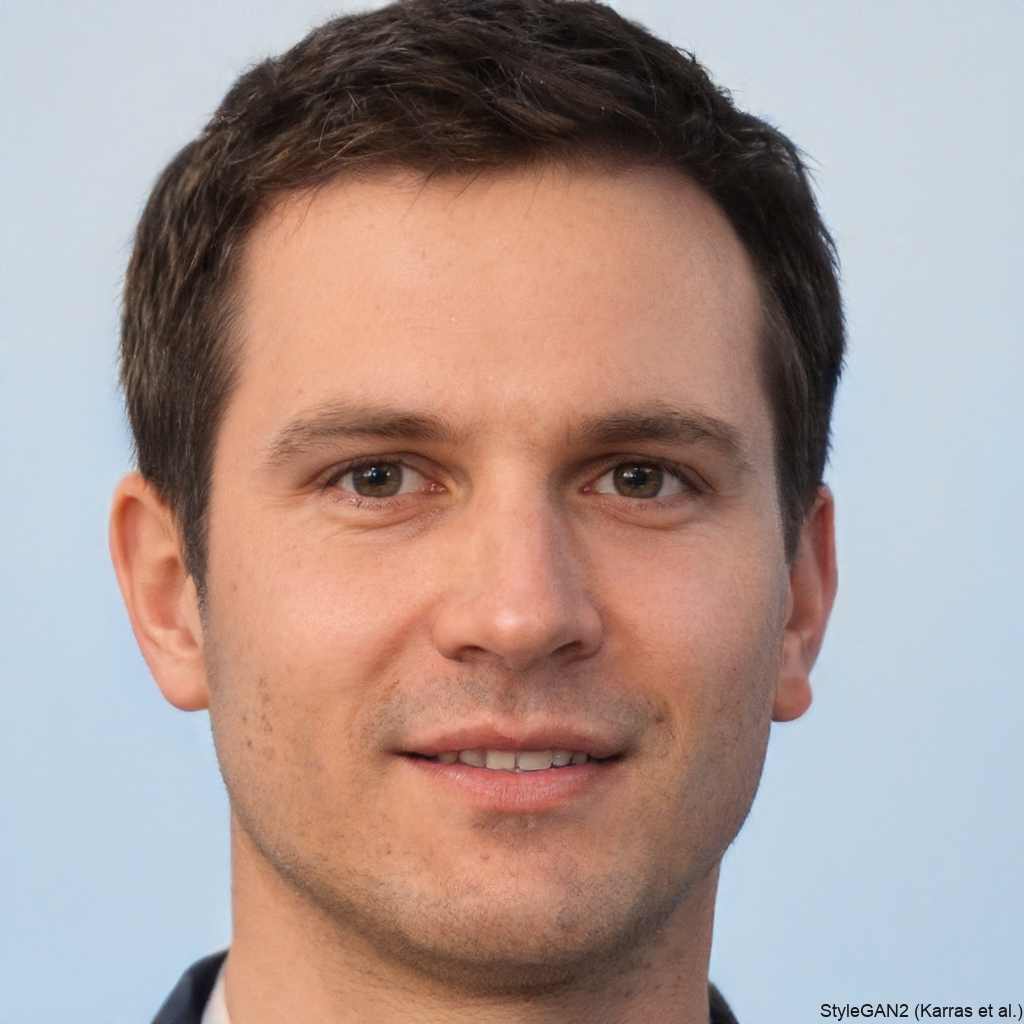In the world of language and culture, saying hello is more than just basic communication. It’s a deep reflection of a society’s values and norms. Korean greetings are a perfect example. They show a lot about the social structures and respect levels in Korean society. There are 27 different ways to say ‘hello’ in Korean, ranging from very formal to very casual. So, what happens when people use these greetings every day? How does it affect their interactions?
Common Korean Greetings
Common Korean greetings cover a variety of situations. One of the most common is ‘안녕하세요’ (annyeonghaseyo), which is a polite way to say hello. If you’re talking to close friends or young people, you might use the more casual ‘안녕’ (annyeong).
Another phrase you’ll often hear is ‘잘 지냈어요?’ (jal jinaesseoyo?), meaning ‘How have you been?’ It’s a good way to reconnect with someone you haven’t seen in a while. Asking ‘밥 먹었어요?’ (bab meogeosseoyo?) or ‘Have you eaten?’ is a common greeting that also shows you care. It highlights the importance of well-being in Korean social etiquette.
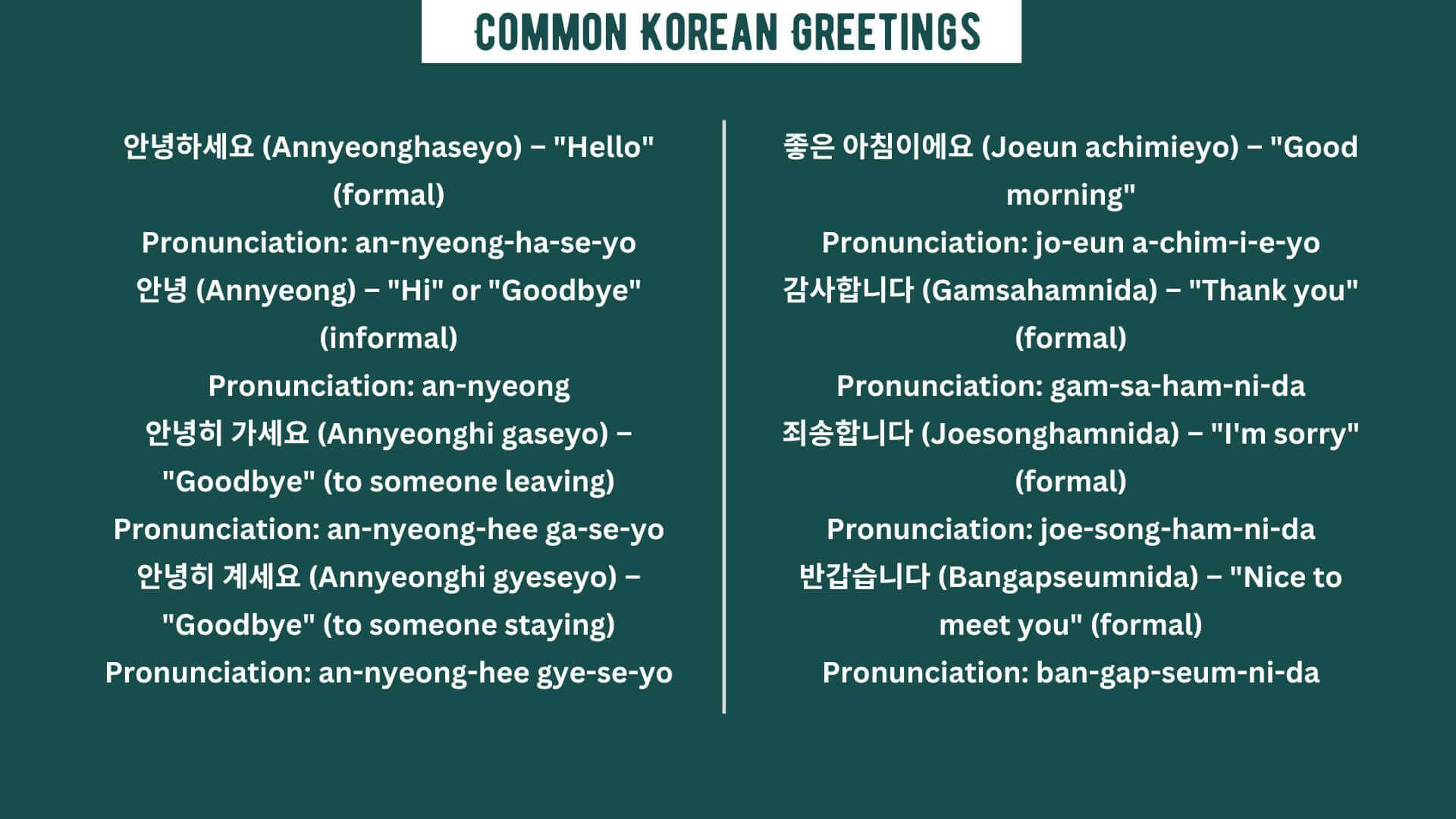
- 안녕하세요 (Annyeonghaseyo) – “Hello” (formal)
Pronunciation: an-nyeong-ha-se-yo - 안녕 (Annyeong) – “Hi” or “Goodbye” (informal)
Pronunciation: an-nyeong - 안녕히 가세요 (Annyeonghi gaseyo) – “Goodbye” (to someone leaving)
Pronunciation: an-nyeong-hee ga-se-yo - 안녕히 계세요 (Annyeonghi gyeseyo) – “Goodbye” (to someone staying)
Pronunciation: an-nyeong-hee gye-se-yo - 오랜만이에요 (Oraenmanieyo) – “Long time no see”
Pronunciation: o-raen-ma-ni-e-yo - 좋은 아침이에요 (Joeun achimieyo) – “Good morning”
Pronunciation: jo-eun a-chim-i-e-yo - 감사합니다 (Gamsahamnida) – “Thank you” (formal)
Pronunciation: gam-sa-ham-ni-da - 죄송합니다 (Joesonghamnida) – “I’m sorry” (formal)
Pronunciation: joe-song-ham-ni-da - 반갑습니다 (Bangapseumnida) – “Nice to meet you” (formal)
Pronunciation: ban-gap-seum-ni-da
Formal Korean Greetings
In Korean culture, it’s important to use formal greetings when you talk to elders, bosses, or in professional situations. This shows respect. The most common formal greeting is “안녕하십니까” (annyeonghasimnikka), meaning ‘Are you at peace?’ You’ll want to use this especially when you meet someone for the first time or at very formal events.
Remember to keep your tone polite. A bow is often expected too, especially if you’re talking to someone older or in a higher position. When someone greets you this way, you should reply with the same phrase, “안녕하십니까.” Getting these details right helps everyone get along and keeps things smooth in Korean social life.
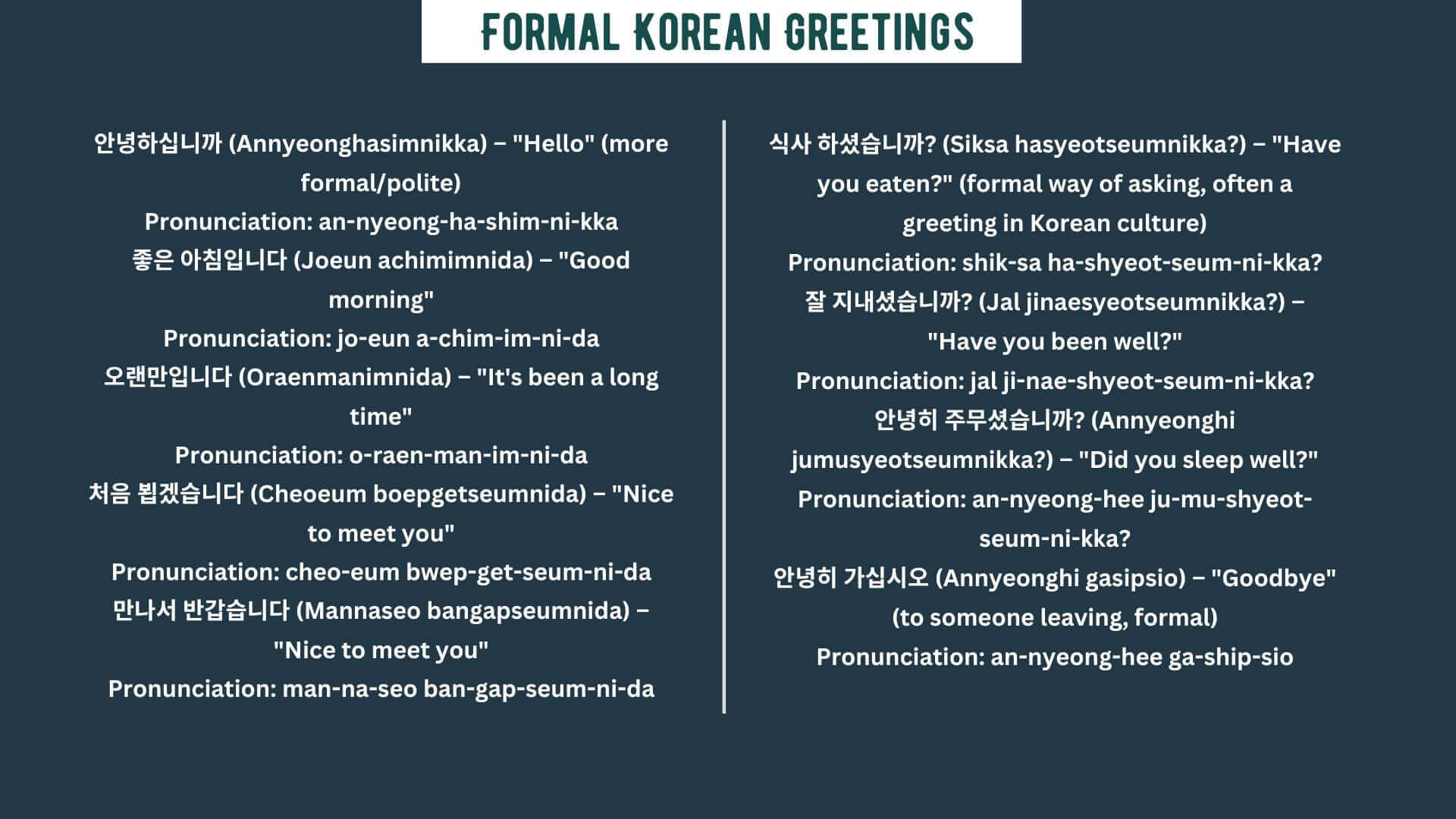
- 안녕하십니까 (Annyeonghasimnikka) – “Hello” (more formal/polite)
Pronunciation: an-nyeong-ha-shim-ni-kka - 좋은 아침입니다 (Joeun achimimnida) – “Good morning”
Pronunciation: jo-eun a-chim-im-ni-da - 오랜만입니다 (Oraenmanimnida) – “It’s been a long time”
Pronunciation: o-raen-man-im-ni-da - 처음 뵙겠습니다 (Cheoeum boepgetseumnida) – “Nice to meet you”
Pronunciation: cheo-eum bwep-get-seum-ni-da - 만나서 반갑습니다 (Mannaseo bangapseumnida) – “Nice to meet you”
Pronunciation: man-na-seo ban-gap-seum-ni-da - 식사 하셨습니까? (Siksa hasyeotseumnikka?) – “Have you eaten?” (formal way of asking, often a greeting in Korean culture)
Pronunciation: shik-sa ha-shyeot-seum-ni-kka? - 잘 지내셨습니까? (Jal jinaesyeotseumnikka?) – “Have you been well?”
Pronunciation: jal ji-nae-shyeot-seum-ni-kka? - 안녕히 주무셨습니까? (Annyeonghi jumusyeotseumnikka?) – “Did you sleep well?”
Pronunciation: an-nyeong-hee ju-mu-shyeot-seum-ni-kka? - 안녕히 가십시오 (Annyeonghi gasipsio) – “Goodbye” (to someone leaving, formal)
Pronunciation: an-nyeong-hee ga-ship-sio
Friendly and Informal Korean Greetings
Switching to casual greetings, these are usually laid-back and friendly, perfect for chatting with friends or co-workers. The most popular one is ‘안녕 (annyeong),’ which means ‘hi’ or ‘hello.’ You’d use this when talking to someone around your age in a relaxed setting. It’s all about keeping things easy and warm, ditching the stiff formalities. Saying ‘안녕’ helps create a friendly vibe, making it great for daily chit-chat among youngsters or with pals at work. It helps strengthen connections by being simple and welcoming.
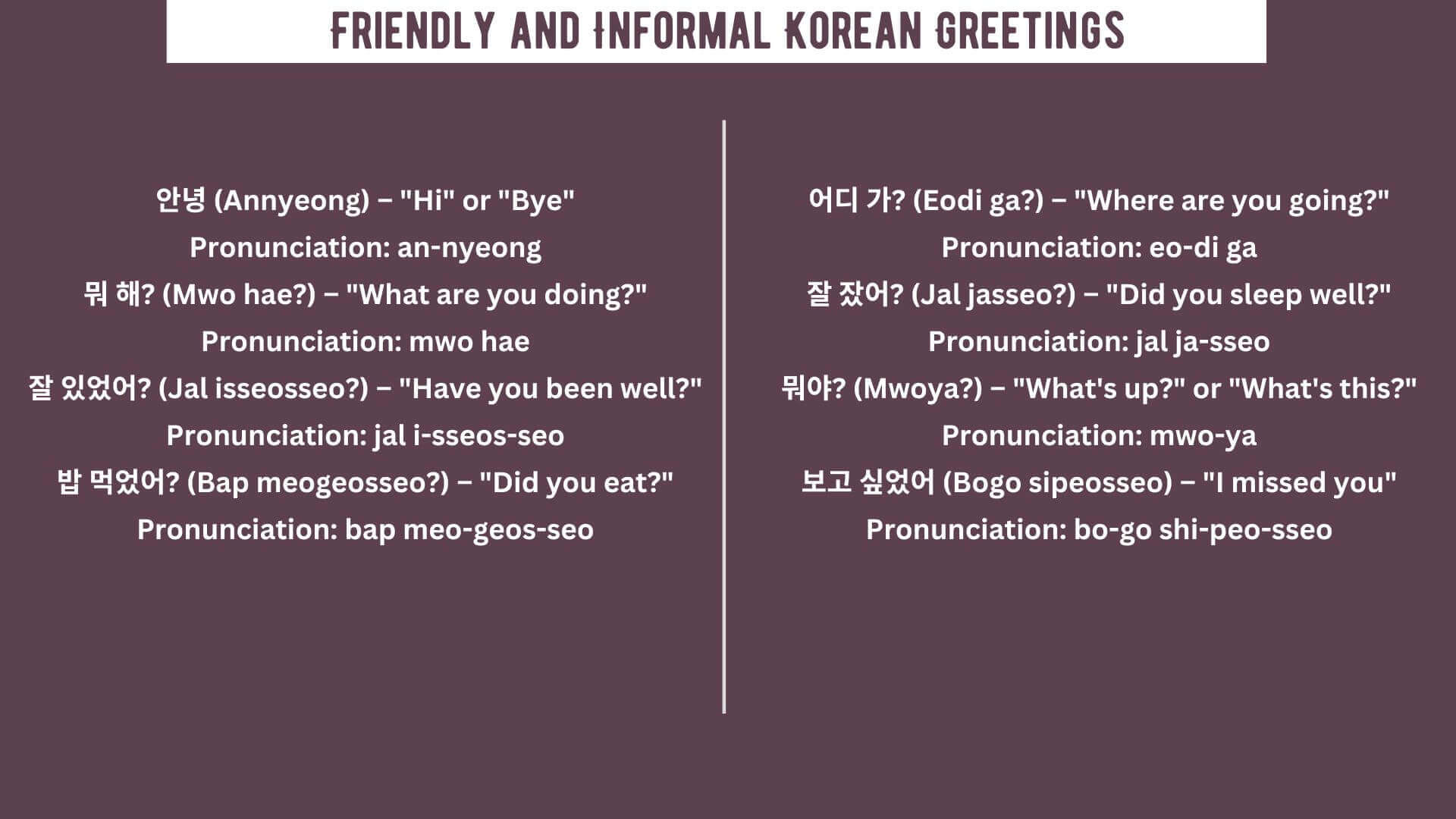
- 안녕 (Annyeong) – “Hi” or “Bye”
Pronunciation: an-nyeong - 뭐 해? (Mwo hae?) – “What are you doing?”
Pronunciation: mwo hae - 잘 있었어? (Jal isseosseo?) – “Have you been well?”
Pronunciation: jal i-sseos-seo - 밥 먹었어? (Bap meogeosseo?) – “Did you eat?”
Pronunciation: bap meo-geos-seo - 어디 가? (Eodi ga?) – “Where are you going?”
Pronunciation: eo-di ga - 잘 잤어? (Jal jasseo?) – “Did you sleep well?”
Pronunciation: jal ja-sseo - 뭐야? (Mwoya?) – “What’s up?” or “What’s this?”
Pronunciation: mwo-ya - 보고 싶었어 (Bogo sipeosseo) – “I missed you”
Pronunciation: bo-go shi-peo-sseo
Also Read: How To Say “Happy Birthday” In Korean: An Ultimate Guide
Unique and Casual Ways to Say Hello
Exploring fun, relaxed ways to say hello in Korean can make your daily chats more engaging. ‘야!’ (Ya!) is a quick, friendly greeting among close friends. It shows you’re comfortable with each other. In texts, Koreans often use ‘ㅎㅇ’ (hi), a short version of ‘하이’ (hai, which means ‘hi’). This is a trendy way to say hello quickly.
Another playful greeting is ‘밥 먹었어?’ (bab meogeosseo?, meaning ‘Have you eaten?’). This question is not just a greeting; it reflects how important meals are in Korean social life. These greetings show how lively and context-rich casual Korean language can be.
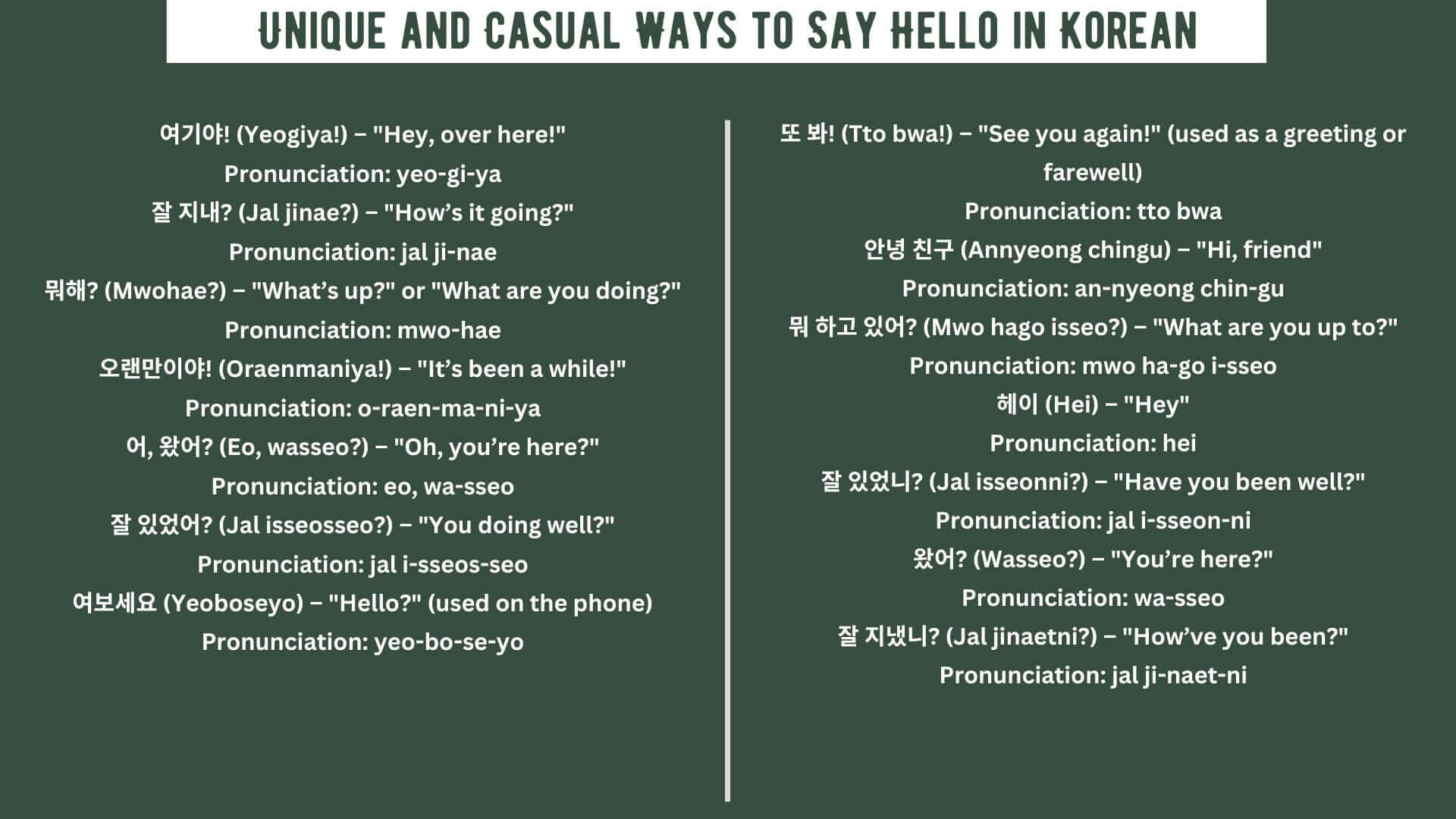
- 여기야! (Yeogiya!) – “Hey, over here!”
Pronunciation: yeo-gi-ya - 잘 지내? (Jal jinae?) – “How’s it going?”
Pronunciation: jal ji-nae - 뭐해? (Mwohae?) – “What’s up?” or “What are you doing?”
Pronunciation: mwo-hae - 오랜만이야! (Oraenmaniya!) – “It’s been a while!”
Pronunciation: o-raen-ma-ni-ya - 어, 왔어? (Eo, wasseo?) – “Oh, you’re here?”
Pronunciation: eo, wa-sseo - 잘 있었어? (Jal isseosseo?) – “You doing well?”
Pronunciation: jal i-sseos-seo - 여보세요 (Yeoboseyo) – “Hello?” (used on the phone)
Pronunciation: yeo-bo-se-yo - 어떻게 지내? (Eotteoke jinae?) – “How are you?”
Pronunciation: eo-tteo-ke ji-nae - 또 봐! (Tto bwa!) – “See you again!” (used as a greeting or farewell)
Pronunciation: tto bwa - 안녕 친구 (Annyeong chingu) – “Hi, friend”
Pronunciation: an-nyeong chin-gu - 뭐 하고 있어? (Mwo hago isseo?) – “What are you up to?”
Pronunciation: mwo ha-go i-sseo - 헤이 (Hei) – “Hey”
Pronunciation: hei - 잘 있었니? (Jal isseonni?) – “Have you been well?”
Pronunciation: jal i-sseon-ni - 왔어? (Wasseo?) – “You’re here?”
Pronunciation: wa-sseo - 잘 지냈니? (Jal jinaetni?) – “How’ve you been?”
Pronunciation: jal ji-naet-ni - 얼마만이야? (Eolmaman-iya?) – “How long has it been?”
Pronunciation: eol-ma-man-i-ya - 어떻게 지냈어? (Eotteoke jinaesseo?) – “How’ve you been?”
Pronunciation: eo-tteo-ke ji-nae-sseo - 반가워 (Bangawo) – “Nice to see you”
Pronunciation: ban-ga-wo - 오랜만이네 (Oraenman-ine) – “It’s been a long time”
Pronunciation: o-raen-man-i-ne - 뭐 하고 지내? (Mwo hago jinae?) – “What have you been up to?”
Pronunciation: mwo ha-go ji-nae - 어, 뭐야! (Eo, mwoya!) – “Oh, what’s up!”
Pronunciation: eo, mwo-ya - 너 왔어? (Neo wasseo?) – “You came?”
Pronunciation: neo wa-sseo - 잘 지냈어? (Jal jinaesseo?) – “Have you been good?”
Pronunciation: jal ji-nae-sseo - 다녀왔어? (Danyeowasseo?) – “You’re back?”
Pronunciation: da-nyeo-wa-sseo
Conclusion
In short, knowing how to say hello in Korean is key to connecting with Korean culture. These greetings range from very formal to very casual. They do more than help us talk to each other — they show respect and build friendships. When you use the right greeting for the situation, you get along better with others and show you value their ways. Really, getting good at these greetings makes your interactions richer and helps you fit in better with everyone in Korea. Keep visiting the Translation Blog to master any language easily.

